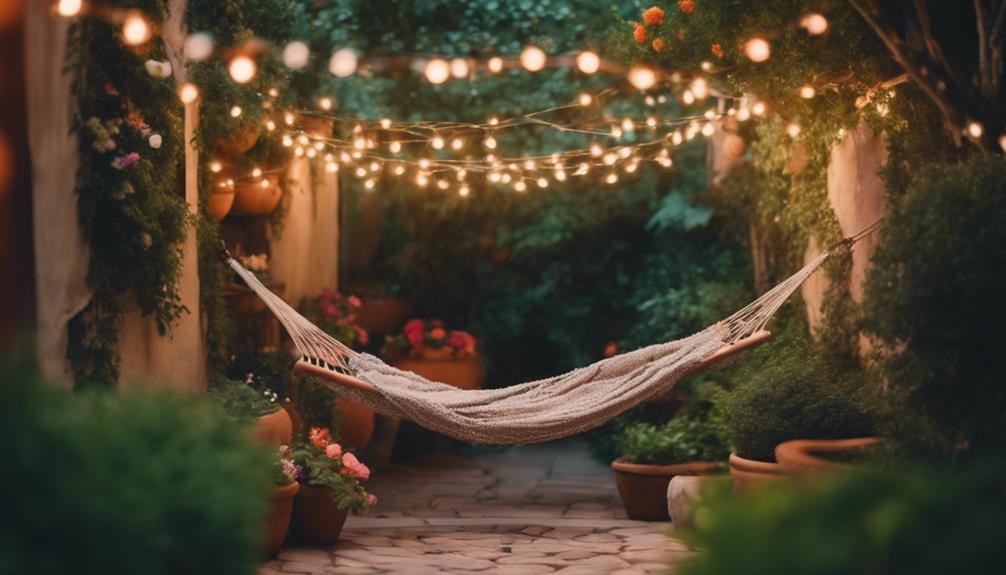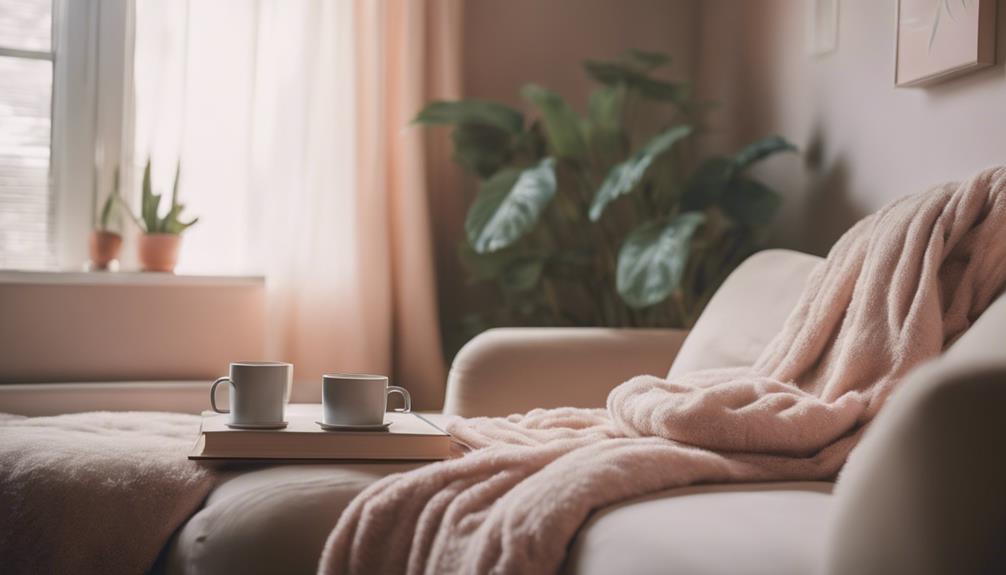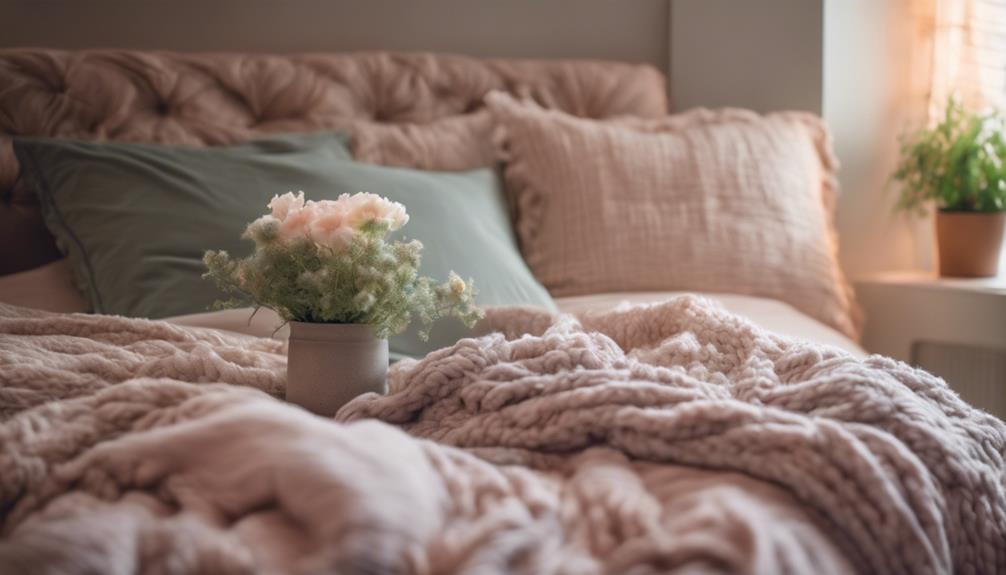You can easily turn your backyard into a secret paradise with enchanting decor and cozy spaces. Start by adding a charming arbor draped in climbing flowers and line your pathways with solar lights. Create privacy with lattice fences and lush evergreens, and include inviting seating like colorful benches or hammocks. Enhance tranquility with soothing water features, like small ponds or fountains that attract birds and butterflies. Don't forget unique artistic elements and wildlife-friendly plants to enrich your ecosystem. A well-thought-out combination of these ideas will transform your outdoor space, promising more inspiration for your garden oasis.
Key Takeaways
- Create enchanting entrances with arbors, winding pathways, and solar lights for a whimsical atmosphere.
- Design cozy privacy nooks using lattice fences, evergreen plants, and comfortable seating for relaxation.
- Incorporate tranquil water features like ponds and fountains to enhance serenity and attract wildlife.
- Use artistic decor elements, such as unique sculptures and fairy lights, to reflect personal style and charm.
- Select native plants for biodiversity, seasonal blooms, and to support local wildlife in your garden.
Enchanting Entrances
Create an enchanting entrance to your backyard by installing garden arbors draped with climbing flowers that invite exploration into your secret paradise. These arbors not only frame the entrance but also create a whimsical atmosphere that draws guests in.
To enhance the experience, choose pathways made of gravel, stepping stones, or wood chips, incorporating gentle curves to evoke a fairy-tale aesthetic.
Brighten the way with solar lights along your entrance paths, guiding visitors through your enchanting garden even after sunset. Pair beautiful plants with your arbors, using lush greenery and vibrant pink blooms to create a stunning visual contrast that welcomes everyone.
Don't forget to add vintage or artistic decor elements. Whimsical sculptures or decorative lanterns add character and charm, making your entrance feel even more inviting.
These thoughtful touches guarantee that the entrance to your secret garden feels special and unique. By combining these elements, you'll transform your backyard into a mesmerizing retreat, enticing anyone who approaches to step inside and explore the beauty that awaits.
Cozy Privacy Nooks
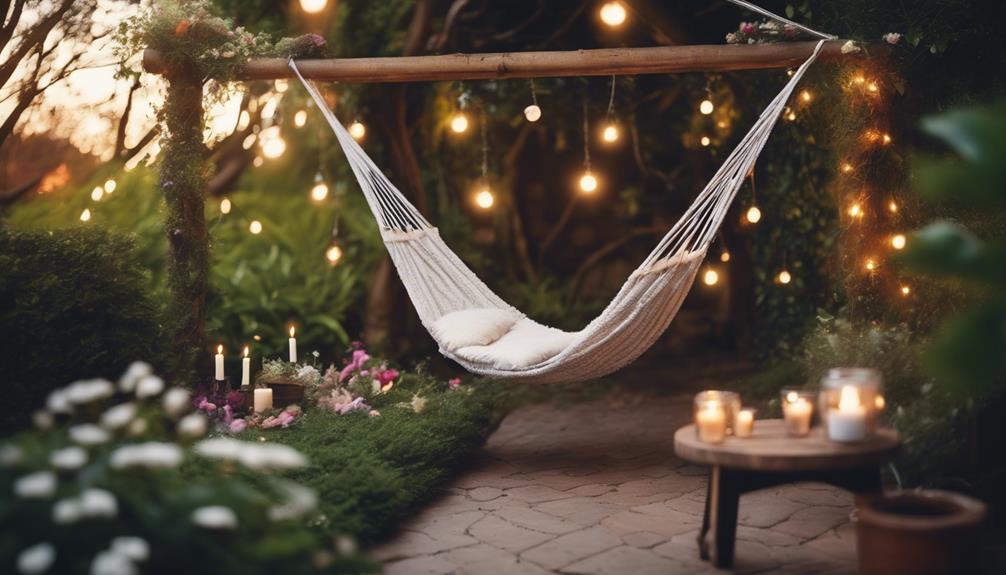
Transforming a neglected corner of your backyard into a cozy privacy nook can provide a peaceful escape where you can unwind and connect with nature. To create a secret garden that feels like your personal retreat, you can incorporate various elements that enhance both comfort and seclusion.
- Lattice fences for an economical and attractive boundary.
- Evergreen plants like Arborvitae or Bamboo to create natural screens.
- Comfortable seating options such as benches or hammocks surrounded by lush foliage.
These cozy privacy nooks invite you to relax, read a book, or simply enjoy the sounds of nature.
By adding strategically placed cushions and throws, you not only enhance comfort but also introduce vibrant colors and textures to your nook.
Designing winding pathways of gravel or stepping stones can lead to these hidden areas, promoting exploration and tranquility.
With thoughtful planning, your backyard can transform into a serene oasis where you can escape the world and enjoy the beauty of nature.
Embrace the opportunity to create a cozy nook that reflects your style and offers a slice of paradise just outside your door.
Lush Plant Selection

When choosing plants for your garden, consider the benefits of native species that thrive in your area and support local wildlife.
Seasonal planting strategies can guarantee your garden blooms year-round, adding color and life to your backyard.
Native Plant Benefits
Have you ever considered how native plants can elevate your garden's beauty while supporting the local ecosystem? By choosing native plants, you not only enhance your green space but also create a thriving habitat for local wildlife. These plants are perfectly adapted to your local climate and soil, making them low-maintenance options that require less water and care than non-native species.
Imagine your backyard filled with:
- Vibrant seasonal blooms that reflect the natural beauty of your region.
- Butterflies and birds enjoying the food and shelter provided by native flora.
- Deep-rooted plants that stabilize soil and reduce erosion, contributing to a healthier environment.
Native plants are often resistant to local pests and diseases, which means you can enjoy a flourishing garden without relying on harsh chemicals.
Plus, they promote biodiversity, creating a balanced ecosystem right in your backyard. By incorporating native plants, you'll transform your outdoor space into a secret paradise that not only looks stunning but also nurtures the environment around you.
Seasonal Planting Strategies
Incorporating seasonal planting strategies not only complements the beauty of native plants but also assures your garden remains vibrant throughout the year. By choosing a variety of plants that bloom in different seasons, you'll create a stunning visual experience. Consider spring tulips, summer daisies, and fall asters to keep your garden lively.
Implement staggered planting times for your seasonal flowers to guarantee overlapping bloom periods, which will provide continuous color. Opt for perennials as a long-term investment; they'll return year after year, enhancing sustainability while reducing replanting efforts. Native species are also a fantastic choice, as they're well-adapted to local conditions, require less maintenance, and support local wildlife.
Here's a quick reference table to help you with your lush plant selection:
| Season | Plant Suggestions |
|---|---|
| Spring | Tulips, Hyacinths |
| Summer | Daisies, Sunflowers |
| Fall | Asters, Mums |
| Winter | Evergreens, Winterberry |
Don't forget to enhance your seasonal planting strategies with decorations like pumpkins or festive ornaments, celebrating the beauty of each season in your secret paradise.
Inviting Seating Arrangements
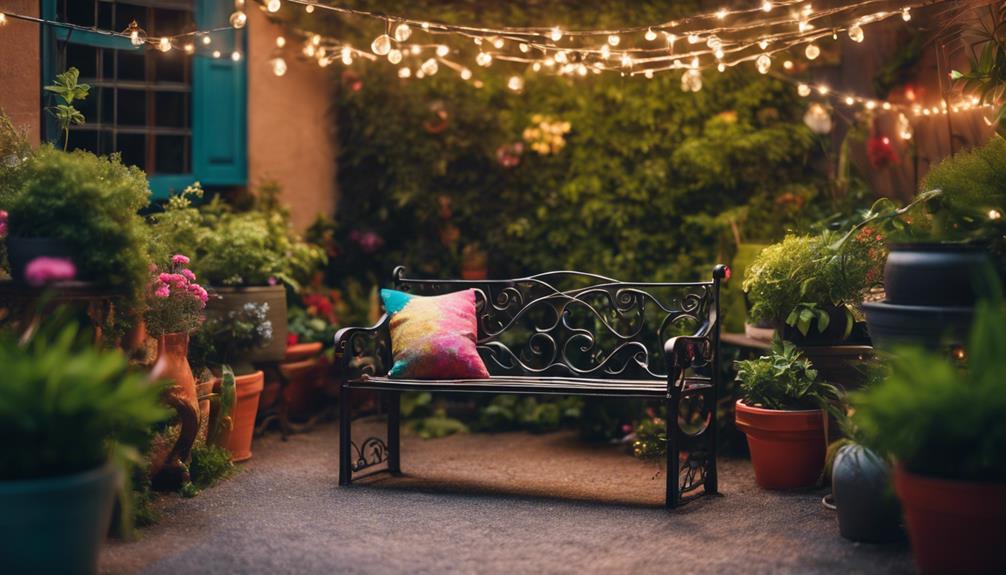
Creating inviting seating arrangements can transform your backyard into a cozy retreat.
By adding benches or hammocks, you can enjoy scenic views while maintaining your privacy.
Let's explore how to position these cozy spots for maximum comfort and relaxation.
Cozy Benches and Hammocks
Cozy benches and hammocks nestled among lush foliage invite relaxation and contemplation, transforming your backyard into an intimate retreat. Imagine sinking into a soft hammock, gently swaying as you listen to the rustle of leaves or the chirping of birds. Incorporating these inviting seating arrangements enhances your outdoor living experience and encourages leisurely moments spent in nature.
To create the perfect cozy nook, consider:
- Strategically placed benches surrounded by greenery for a peaceful reading spot.
- Colorful cushions and throws that add comfort and style, making your space truly inviting.
- Weather-resistant materials for hammocks and benches, ensuring durability through changing seasons.
Scenic Views and Privacy
Inviting seating arrangements not only enhance comfort but also provide stunning views and much-needed privacy in your backyard paradise. By positioning benches and chairs to overlook blooming flower beds or tranquil water features, you create a serene atmosphere that invites relaxation.
Consider adding cozy nooks filled with cushions and throws, surrounded by dense foliage, to offer comfort and seclusion for intimate gatherings. To provide privacy, incorporate natural screening elements like Arborvitae or bamboo. These plants effectively block out noise and visual distractions from neighboring properties, allowing you to fully immerse yourself in your garden retreat.
Additionally, installing garden arbors and trellises adorned with climbing plants can create charming entryways and pathways leading to hidden seating spots, enhancing the sense of discovery. Make certain to position your outdoor furniture strategically to take advantage of scenic views while maintaining a sense of seclusion.
Unobstructed sightlines guarantee you can enjoy the beauty around you without feeling exposed. By thoughtfully designing your seating arrangements, you'll transform your backyard into a tranquil escape that balances scenic views with the privacy you desire.
Tranquil Water Features
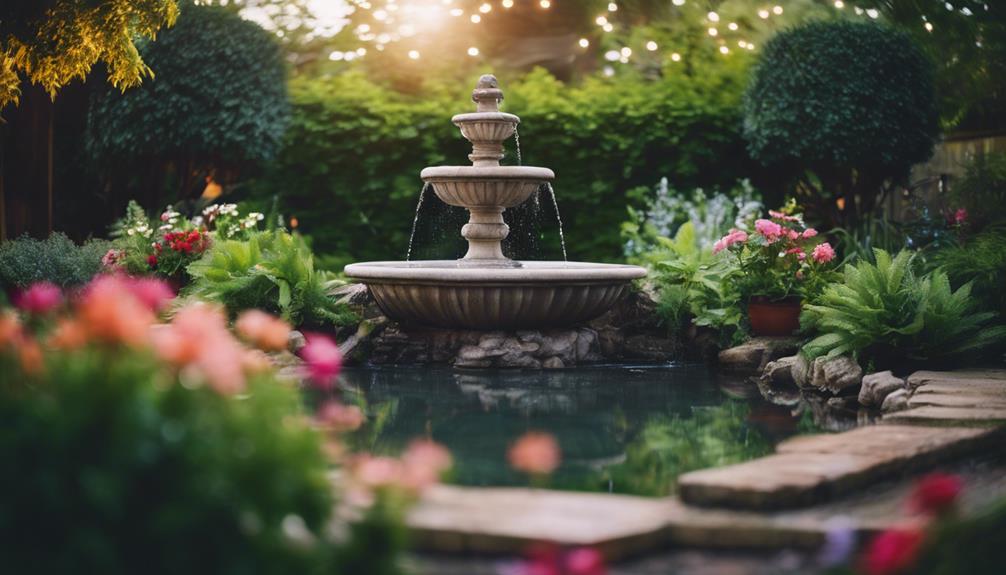
Tranquil water features transform your backyard into a serene oasis, attracting wildlife and enhancing relaxation with soothing sounds and beautiful visuals. Imagine the gentle trickle of water as it cascades from a fountain, creating a peaceful atmosphere that invites you to unwind after a long day.
Consider these options to elevate your outdoor space:
- A small pond with aquatic plants, providing a natural habitat for frogs and beneficial insects while enhancing tranquility.
- A charming fountain that serves as an aesthetic focal point, whether it's a wall-mounted design or a free-standing structure, producing soothing sounds that melt stress away.
- A birdbath adorned with colorful stones, inviting local birds to visit and adding vibrancy to your garden.
Installing these water features not only adds beauty but also creates a calming ambiance that drowns out nearby noise.
Just remember, regular maintenance is key to keeping your water feature clean and functional, ensuring it remains a beautiful element in your secret garden.
Embrace the tranquility, and let your backyard become a peaceful retreat where you can connect with nature.
Artistic Decor Elements
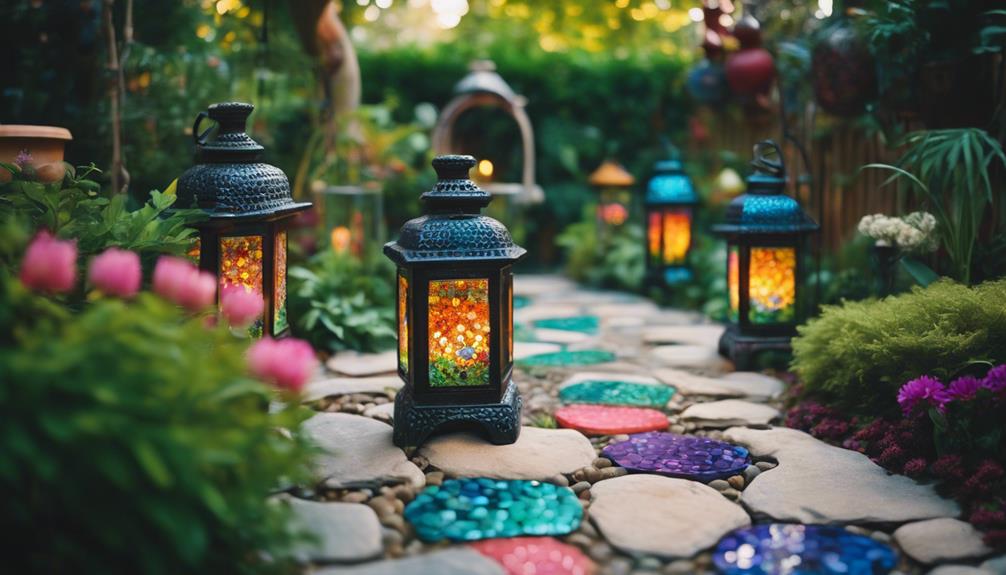
Building on the calming atmosphere created by water features, artistic decor elements can greatly enhance the character and charm of your backyard space. Incorporating unique garden art, like sculptures or reclaimed vintage furniture, adds inviting focal points that draw the eye and reflect your personal style. Imagine a stunning metal sculpture that not only serves as a conversation starter but also complements the natural surroundings.
To create a magical atmosphere, consider using fairy lights or lanterns to illuminate pathways and seating areas. This lighting transforms your garden into a cozy retreat at night, inviting you and your guests to linger longer. You might also design a themed area, such as a fairy garden or a zen space, which encourages exploration and adds distinct character to your outdoor sanctuary.
Don't shy away from creativity—upcycle old tools or scrap metal into artistic sculptures. This not only adds a unique touch but also promotes sustainability, making your garden decor eco-friendly. By blending these artistic decor elements, you'll turn your backyard into a secret paradise that reflects your personality and invites relaxation.
Wildlife-Friendly Gardens
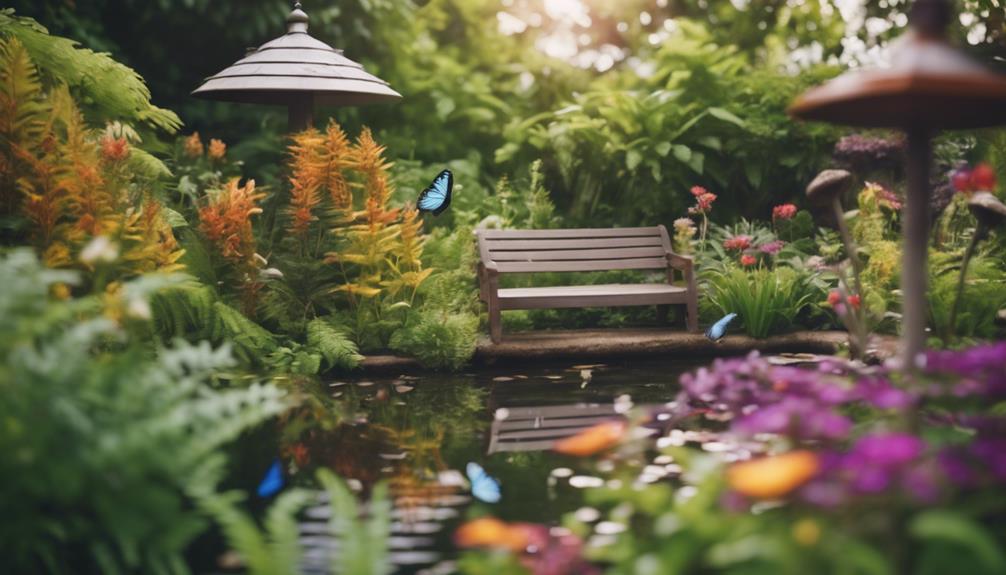
Creating a wildlife-friendly garden not only enriches your outdoor space but also supports local ecosystems in need of habitats and food sources. Even if you have a small space, you can attract fascinating wildlife and contribute to biodiversity.
Here are some simple ways to get started:
- Plant nectar-rich flowers like milkweed and coneflowers to draw in bees and butterflies.
- Install birdhouses and feeders to provide shelter and food for local birds, turning your garden into a vibrant ecosystem.
- Create bee hotels using hollow stems and wooden blocks to support solitary bees, crucial for plant pollination.
Creative Upcycling Ideas

Enhancing your backyard can be both eco-friendly and stylish by incorporating creative upcycling ideas that breathe new life into old items.
Start by transforming wooden pallets into chic garden furniture like benches or tables. A little sanding and staining will give them a rustic look that fits perfectly into your garden space.
Next, consider repurposing glass jars and bottles. You can create unique plant holders or lanterns by painting them or adding fairy lights, which will add a magical ambiance to your outdoor area.
Vintage suitcases also make for fantastic planters or side tables; just remove the lids and guarantee proper drainage for your plants.
For a touch of whimsy, turn old kitchen utensils like forks and spoons into playful plant markers or sculptures. This fun project adds character to your garden while showcasing your creativity.
Finally, wooden crates can be upcycled into vertical planters or shelving units, maximizing your space while offering a charming aesthetic.
With these ideas, you'll not only beautify your garden but also embrace the spirit of upcycling!
Seasonal Color Themes
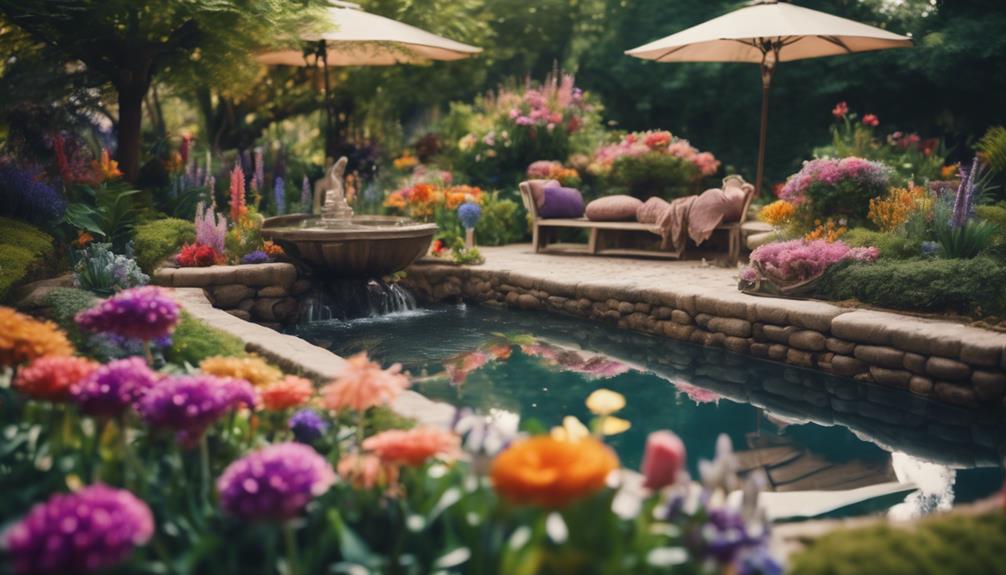
Incorporating seasonal color themes in your backyard not only boosts visual interest but also allows you to celebrate the changing beauty of nature throughout the year. By carefully selecting plants that bloom in different seasons, you can create a dynamic garden that evolves with each passing month.
Consider these ideas to enhance the look and feel of your outdoor space:
- Spring: Embrace pastel blooms like tulips and daffodils to welcome warmer days.
- Summer: Brighten your garden with vibrant sunflowers and zinnias, adding a cheerful touch.
- Fall: Use warm hues like oranges and reds with chrysanthemums and ornamental cabbages for a cozy ambiance.
Don't forget about winter! Incorporate evergreen plants and colorful berries from holly or winterberry to keep your garden lively.
By choosing a cohesive color palette, you guarantee a harmonious flow that makes the changes between seasons visually appealing. Planting seasonal flowers that bloom at different times, such as bluebonnets in spring, assures your garden remains engaging all year round.
Embrace these seasonal color themes, and watch your backyard become a secret paradise!
Conclusion
Transforming your backyard into a secret paradise is all about personal touches and thoughtful design.
Did you know that gardens can increase your property value by up to 20%?
By incorporating enchanting entrances, cozy privacy nooks, and inviting seating arrangements, you'll create a space that's not just beautiful but also functional.
Add in some tranquil water features and artistic decor, and you'll be well on your way to enjoying a serene retreat right at home.
